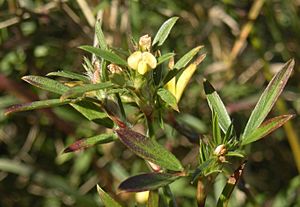Stylosanthes facts for kids
Quick facts for kids Stylosanthes |
|
|---|---|
 |
|
| Stylosanthes hamata | |
| Scientific classification |
|
| Kingdom: | Plantae |
| Clade: | Tracheophytes |
| Clade: | Angiosperms |
| Clade: | Eudicots |
| Clade: | Rosids |
| Order: | Fabales |
| Family: | Fabaceae |
| Tribe: | Dalbergieae |
| Genus: | Stylosanthes Sw. |
| Species | |
|
See text |
|
Stylosanthes is a group of flowering plants often called pencilflowers. They belong to the legume family, which is also known as Fabaceae. These plants are very important for feeding animals, especially in pastures, which are fields where animals graze.
Contents
What Stylosanthes Looks Like
These plants have leaves made of three leaflets, like a clover. Their flowers are small and usually yellow.
Some Stylosanthes species are annuals, meaning they live for only one growing season. Others are perennials, which means they live for more than two years.
The way these plants grow can change. For example, S. scabra can grow into a small woody bush up to 1.5 meters (about 5 feet) tall. But other species, like S. humilis, might grow as a leafy plant that spreads low to the ground. This low growth helps them survive when animals graze on them a lot.

Where Stylosanthes Grows
Most Stylosanthes species, except for two, are originally from North and South America.
One species, S. fruticosa, grows naturally from South Africa all the way to Ethiopia, across the Arabian Peninsula, and into Pakistan, India, and Sri Lanka. Another species, S. erecta, is found only in tropical parts of Africa, from Tanzania to Senegal.
These plants can grow in many different environments. You can find them in dry grasslands called savannas, thorny bush areas, tropical forests, and even in mountain forests.
How Stylosanthes is Used
Stylosanthes plants are very useful for many reasons, especially for farming and helping the environment.
Feeding Animals
These plants are excellent for feeding farm animals. They are high in protein, which helps animals grow strong.
One special thing about Stylosanthes is that they can do something called nitrogen fixation. This means they can take nitrogen gas from the air and turn it into a form that plants can use. This helps make the soil healthier and more fertile. They can also get phosphorus from the soil, even when other plants can't.
The seeds of Stylosanthes are tough and can live for a long time in the soil. This means that after a fire or heavy grazing, new plants can quickly grow back from these stored seeds. Animals that eat the seeds also help spread them around, because the seeds can pass through their digestive system unharmed. Many species can also handle hot, dry weather and don't need much water.
Because of these helpful traits, Stylosanthes is the most widely used tropical pasture legume in the world. It has been brought to many tropical countries to improve pastures. In Australia, for example, millions of acres of land have been planted with Stylosanthes species like S. hamata, S. scabra, and S. humilis. This can make the land much more productive for grazing animals. They are also very important for pastures in South America, tropical India, and tropical Africa.
Helping the Soil
Stylosanthes species are also used as "green manure" in places like West and Central Africa. This means they are grown to improve the soil, then plowed back into it.
In China and India, some species like S. guianensis and S. hamata are grown and harvested to make leaf meal. This meal is then used as food for chickens and pigs.
These plants can also add nitrogen to farming systems that don't use many chemicals. Farmers in Peru, Africa, and Australia use them as "fallow species," meaning they are planted on land that is resting from growing crops. In India and Africa, S. hamata is sometimes grown between rows of grain crops, which can increase the harvest by up to 25%.
Stylosanthes plants are also used to fix damaged land, stop soil from washing away (soil stabilization), and make poor soil healthy again (soil regeneration). This is because they can survive dry conditions, improve soil health, and provide a lasting plant cover.
Potential Problems
Even though Stylosanthes plants are very helpful, they can sometimes cause problems.
If they grow too much, they can take over pastures and push out grasses. This can be an issue because grasses often protect the soil from erosion better than Stylosanthes does.
Too much Stylosanthes can also make the soil more acidic. This happens when nitrogen levels build up and then wash deeper into the soil.
Some Stylosanthes species are considered invasive species or environmental weeds in places like Australia, Taiwan, the Pacific Islands, and Hawaii. This means they can spread quickly and harm local ecosystems.
Many Stylosanthes species can also get a plant disease called anthracnose fungus. This disease can stop the plants from growing well and prevent them from making seeds. Because of this, some types of Stylosanthes that farmers used to grow have been abandoned.
See also
 In Spanish: Stylosanthes para niños
In Spanish: Stylosanthes para niños

